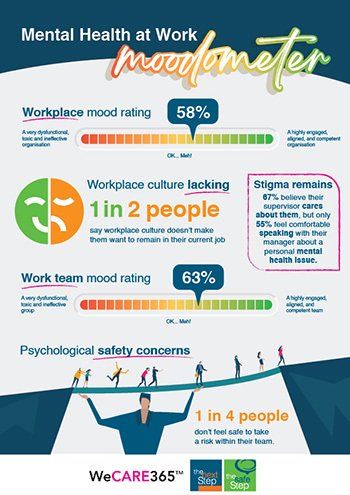The Mental Health at Work Moodometer study is revealing a crisis in the workforce. Conducted by mental health expert Graeme Cowan and The Safe Step, the study looks at mood and mental wellbeing in Aus
Page Published Date:
July 25, 2022
Mental health Moodometer
Mental health concerns are on the rise, with the latest Census data revealing that 10% of Australia's population have a chronic mental health issue. The issue is affecting workplaces creating concerns for wellbeing, productivity and stability. In light of this, it's no suprise that a recent Atlassian study found mental health was the #1 societal issue employees care about*, placing wellbeing above climbing the career ladder.
To determine how mental health concerns are impacting Australian's at work, we recently conducted a Moodometer survey. The questionnaire looked at mood on a personal, team and organisational level, addressing issues such as stress, psychological safety and access to support.
This is the first quarterly survey of mental health at work and sets a baseline for future Moodometer results.
Mood in Australian workplaces a concern
When asked to rate the mood in their workplace from “dysfunctional and toxic” to “highly engaged and competent” the Mental Health at Work Moodometer landed at 58% which means almost more than half feel “meh” about their workplace. This is a concern for employers
Respondents feel a little better about the teams they work in with the Moodometer swinging to 63% believing those teams are “engaged, aligned and competent.”
The personal mood rating was even higher with 66% believing they are “firing on all cylinders”
Furthermore, the outlook for many employees remains gloomy. 45% of respondents revealed they don’t believe their mental health will get better in the next 3 months.
Workforce unrest: culture a problem
Only half of Australian employees surveyed say their culture makes them want to stay in their current role, posing a considerable risk for employers.
“With record-high job opportunities available at the moment, employers are risk losing employees who don’t feel safe, secure and supported,” says Jo Skipper, Managing Director of The Next Step.
Making people feel safe at work and fundamentally cared for is important if we are to see a more stable and motivated workforce. Mental health expert Graeme Cowan agrees and believes this unfortunate combination of unrest and poor communication is today’s leadership challenge.
Stigma a concern for managers
67% of people believe that their manager cares about them, but mental health stigma is high with only 55% feeling comfortable speaking to a supervisor about a personal mental health challenge.
While the majority of people have access to practical mental health programs within the workplace, open discussion with supervisors proves a challenge for many.
Organisations are increasing their investment in wellbeing, hiring specialists to drive a more informed, evidence and risk-based approach and these results suggest that is prudent.
How we can help
If you would like to know more about this report please reach out to your Safe Step consultant or contact us.
We can also assist with providing subject matter experts on a permanent or temporary basis to support HR and HSE teams develop or execute wellbeing strategies.





